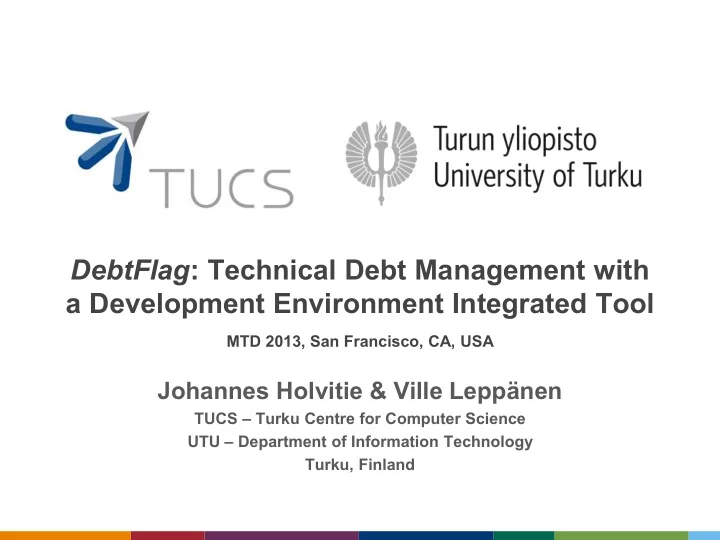

DebtFlag : Technical Debt Management with a Development Environment Integrated Tool MTD 2013, San Francisco, CA, USA Johannes Holvitie & Ville Leppänen TUCS – Turku Centre for Computer Science UTU – Department of Information Technology Turku, Finland
Motivation and Problem • Availability and clarity of technical debt information is a key factor in successful technical debt management • Software products are highly complex, self- emergent and experience constant updates • Two approaches to TD information production • Automatic: accommodates update rates; incapable of capturing entire requirements space • Manual: capable of capturing the entire requirements space; incapable of accommodating update rates
Solution • Combine the two approaches • Manual assessment to identify source points • Partially automate the documentation process • Fully automate the processes of propagation and technical debt information maintenance
DebtFlag • DebtFlag links structured observations about technical debt to related parts of the software implementation and • uses implementation technique specific information to maintain them. • DebtFlag produced technical information pursues technical debt management at • the implementation level (micromanagement) • the project level (adherence to TDMF)
DebtFlag • DebtFlag mechanism • software implementation process and technique independent, system abstraction • structure of documented technical debt • automation of technical debt propagation • technical debt management • DebtFlag tool • implementation of the DebtFlag mechanism • Java (Eclipse plug-in + Vaadin web-app)
DebtFlag Mechanism Structure of Documented Technical Debt • Uses the documentation structure from Technical Debt Management Framework* • Extends this with an additional layer • TDIs composed from DebtFlag elements • user may define a TDI as an unlimited collection of implementation technique specified elements • each element may introduce a unique rule set for the propagation of its technical debt * Seaman, C., & Guo, Y. (2011). Measuring and monitoring technical debt. Advances in Computers , 82 , 25-46.
DebtFlag Mechanism Automation of Technical Debt Propagation • DebtFlag’s dynamic functionality requires that two processes are automated • identifying source points for TD propagation • propagation of technical debt according to rule sets and dependencies
DebtFlag Mechanism Technical Debt Management • Project level management • Support for the TDMF • DebtFlag mechanism is designed to be able to efficiently construct and maintain the TDL for the software implementation artifact • Implementation level micromanagement • DebtFlag maintains an implementation level representation of technical debt
DebtFlag Tool • Implementation of the DebtFlag mechanism • DebtFlag plug-in • for the Eclipse IDE • supports developing in Java • TD micromanagement • DebtFlag web-application • dynamic representation of the TDL • project level management
DebtFlag Plug-In – Capturing Technical Debt • Triggered through interaction with Java elements in the Eclipse • Partially automated documentation of technical debt (creation of DebtFlag elements)
DebtFlag Plug-In – Implementation Level Representation of Technical Debt • Micromanagement; visualization and restriction
DebtFlag Web Application – Dynamic Representation of the TDL • Project level TD management • changes propagated back to implementation
Future work • Mechanism Improvement and Validation • Department software projects • Experimentation and case studies with industrial partners • Nokia ICM (legacy code project in Pro*C) • Propagation model improvement • Variety of possible inputs and models to use • Extending technique support
Discussion • Benefits • Drawbacks • Application in software development • Propagation modeling • Propagation analysis
Discussion Expected benefits of using the DebtFlag • captures human made observations • documents the structure of technical debt • presents technical debt at the implementation level • makes continued use of higher level technical debt management approaches possible
Discussion Foreseen drawbacks to using the DebtFlag • may endorse technical debt accumulation • places the burden of technical debt management onto the end user • does not protect the information from propagation rule set bias • is heavily dependent onto outside services
Application in Software Development • Integrate into parts of the software process where relevant observations are made • Implementation process • Developers are the end users • Produced documentation serves as the integration point for further technical debt management approaches • TDMF or other SW dev. approaches
Propagation Modeling • How does dependency propagation affect TD principal and interest? • forms of propagation • types of implementation elements • Modeling the effect of diminishing TD • Supporting TD management • Possibility in link structure algorithms • PageRank
Propagation Analysis
Recommend
More recommend